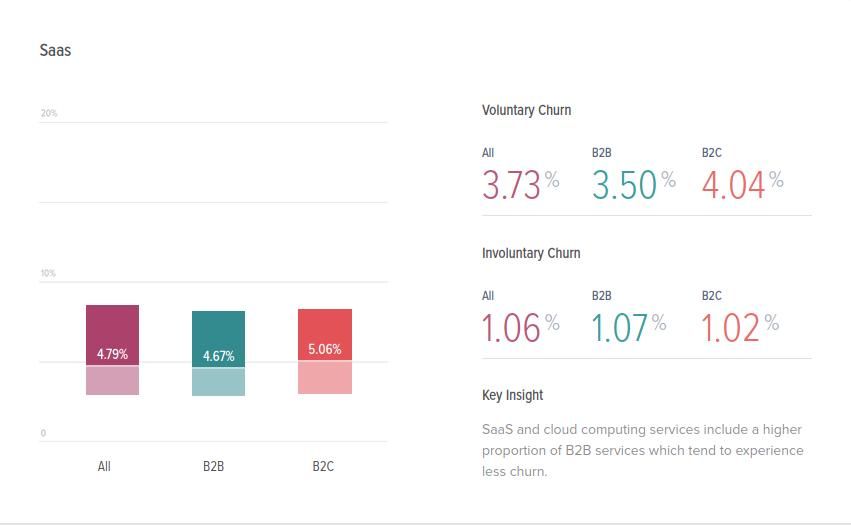In the SaaS world the most feared word is "Churn". It sounds innocuous enough but it often viewed as the harbinger of rejection and defeat and signifies that the customer has decided your product no longer meets their needs.
The challenge for SaaS businesses is to figure out why the customer has churned and even better, predict who is likely to churn and try and intervene to prevent it before it occurs.

How Do You Define Churn?
Customer churn, is the rate at which customers stop doing business with you. It is most commonly expressed as the percentage of customers who discontinue their subscriptions within a specific timeframe. The formula for churn rate is:
$$Churn\ Rate = {No.\ of\ customers\ who\ churned\ this\ period\over No.\ of\ customers\ at\ the\ start\ of\ the\ period}$$
Note: The number of customers who churned this period should also exclude any customers who both joined & churned during the period or churned & reactivated during the period.
What It Means For Your Business
Churn is the opposite of growth. A subscription business is often compared to a leaky container. The liquid coming in is the new customer subscriptions and the liquid leaking from the container is the customer churn. Obviously if the customer churn is high then it will be very hard to fill the container.
When you look at the figures the problem becomes apparent. If at the start the year you have 100 customers and a monthly churn rate of 5% that gives you an annual Retention Rate over a 12 month period of 54%.
$$Retention\ Rate = {(1-0.5)^{12}*100}=0.5404=54\%$$
This means that from the 100 customers at the start of the year you expect 46 of them to churn during the year.
$$Annual\ Churn\ Rate = {(1-0.54)}=46\%$$
So to gain even one more customer by the end of the year, you need to find 47 new customers (46 to replace the churned customers and 1 to give you a net gain).

Churn Rates
There is no right churn rate as it depends on your industry. A good churn rate for you may be terrible for someone else. Typical churn rates for B2B is 3-5% and B2C is 4-7%. A key objective for all SaaS businesses should be to reduce their churn.

10 Reasons for Customer Churn
There are many reasons for churning and tactics for reducing churn, including:
Losing a Champion
This is a very common reason for customer churn. Often the person within the organization who had championed the product in the first place moves on to another role or leaves the organization completely. The new person is not familiar with your product or the problems it solves but has heard about some new shiny product for a friend or often prefers the product they had used in their previous job.
The best way to avoid customer churn due to the loss of a champion is to ensure that your relationship with the customer is wide so there are multiple people who feel comfortable with your product and feel that they have your support to help them.
Company is Acquired
In this case the acquiring company may want to standardize on the same product that they are using too help integrate the newly acquired company into the mother-ship.
This is a very difficult to counter as you often have no relationship with the acquiring company. The best you can do is to start the try sales process again with the acquiring company and elicit support from your customer. You never know.
Bad Initial Fit
Sometimes the reason for churning is just simply because the product never really addressed their needs in the first place and they have just discovered that fact.
There is no way to fix an initial bad fit but it does point to a failure in your sales process. Either your field sales people did a bad job of matching their requirements to your product or your website or sales literature did not accurately describe your product features, functionality and use cases. This situation should be avoided at all costs as it will affect your reputation.
Competitor Poaching
It's a tough market out there and your competitors are not going to sit around. They will actively try to poach your customers by offering discounts and additional services like training, product customization and systems integration to temp your customers to jump ship.
The best way to avoid competitor poaching is to provide the best service, listen to your customers and be aware of your competitors product offering and pricing. You need to ensure that your product is always competitive and the best way to to that is to constantly innovate.
Disappearing Act
Sometimes the customer just disappears. This could be because they have decided to change their business model, or product strategy or just go out of business and no longer require your product.
This is a tough one, how do you talk to someone who does not want to talk to you. The best way is to be patient. The good news is that there is always the possibility that if you maintain a good relationship that they may use your product in the future or even recommend it to someone else.
Stuck at a Certain Level
A good customer success strategy helps your customer to transition from being a basic user through to being an intermediate user to become an advanced user. However customers often grasp the initial basics as this solves the immediate problem but never progress to become an advanced user. This can lead them to underestimate the capability of your product and often go looking for another product to solve a problem that your product can already solve for them.
This is where a good customer success strategy is important. Your objective is not just to generate revenue from a customer it is to help your customer achieve their aims. This can be by providing integration services, training, documentation or just good email, phone or online chat support to help them achieve their aims.
Customer Slacking
Certain customers are just lazy and will not put in the work to get value from your product. As the saying goes you can bring a horse to water but you cannot make it drink.
This can be for a variety of reasons, sometimes the person does not have the required skills, confidence, domain knowledge or simply has other priorities. The best solution is to offer to do as much as possible for them but ultimately someone needs to take responsibility for the project on the customer end.
Poor Product
Nobody want to hear this but sometimes the reason for customer churn is because the quality of your product is low. Facebook famously has the motto of move fast and break things and the lean philosophy of creating minimally viable products can have a downside of frustrating the customer to the point where they have just had enough.
There is a famous saying from Aldo Gucci that Quality is remembered long after the price is forgotten. Quality is important but so is product functionality, listen to your customers and give they an easy way to report bugs and ensure that your products are properly tested before they are released.
Cash Crunch
This reason is relative to your pricing model. Obviously if you are charging a small amount each month then it is not really going to be an affordability issue, but depending on your product or service, the price could well be thousands each month. Smaller less capitalized businesses are more likely to experience this problem. In the enterprise space this rarely occurs. That is why many SaaS businesses prefer to target enterprise customers and they are more likely to have a secure income stream.
Every case has individual circumstances but if it is just a temporary blip in their cash-flow you can look at offering a discount or changing from a yearly to a monthly contract. Alternatively it may be possible to find a third party to offer financing.
Evolution
All businesses are subject to change and sometimes the needs of the business changes and the current product offering cannot fulfill their new needs. So some churn is a normal and natural process.
The only constant is change and your customers needs will change. Your choice is to either change your product to meet their needs or accept that they are no longer in your target market.

The Solution?
Invest in customer success. Provide them with hints, tips and advice so they can get the most from your product. If your customers achieve their aims then they will not even consider churning.
In addition, look for the signs that a customer is considering churning. Use your product usage metrics to monitor the customers engagement. A low engagement metric is a definite warning sign. It could be due to any of the various reasons and you can try to mitigate the effect using the suggested tactics.
However, the best way to reduce churn is to:
Talk to your customers
If you keep in constant communication with your customers and give them an a good channel to ask questions, explain their changing needs, express their frustrations, then at least you can try and stop them from churning.
For SaaS Metrics and Analytics, check out Subbiemetrics



